Being great on social media isn’t always intuitive. Sometimes the best way to learn is to get inspired by the what others are doing.
Late last year, Kapost compiled a list of 2014’s top brands in content. Much of what has made many of these brands successful is their social media strategies.
Let’s learn from six of them here. Whether they’re inspiring their audience through a shared philosophy or learning with their fans and followers by sharing data and studies, these brands—both small and large—have found the winning strategy for their specific personality, voice and values.
Read on to discover what lessons you can learn from these brands and their tactics to develop your own winning social media combination.
Lesson #1: Go all in on images like Hubspot
Great images can have a huge impact on social engagement, as regular readers of this blog well know. Visual content gets 94% more total views and is now 40% more likely to be shared on social networks.
Hubspot pays close attention to the science of visuals, contributing their own original research, and—like our friends here at Buffer—plenty of thought leadership and step-by-step guides on the topic.
The team behind Hubspot are such believers in the power of images that they frequently give away packs of stock photos and have even created 60 customizable templates to help folks with no design expertise create dynamic social imagery.
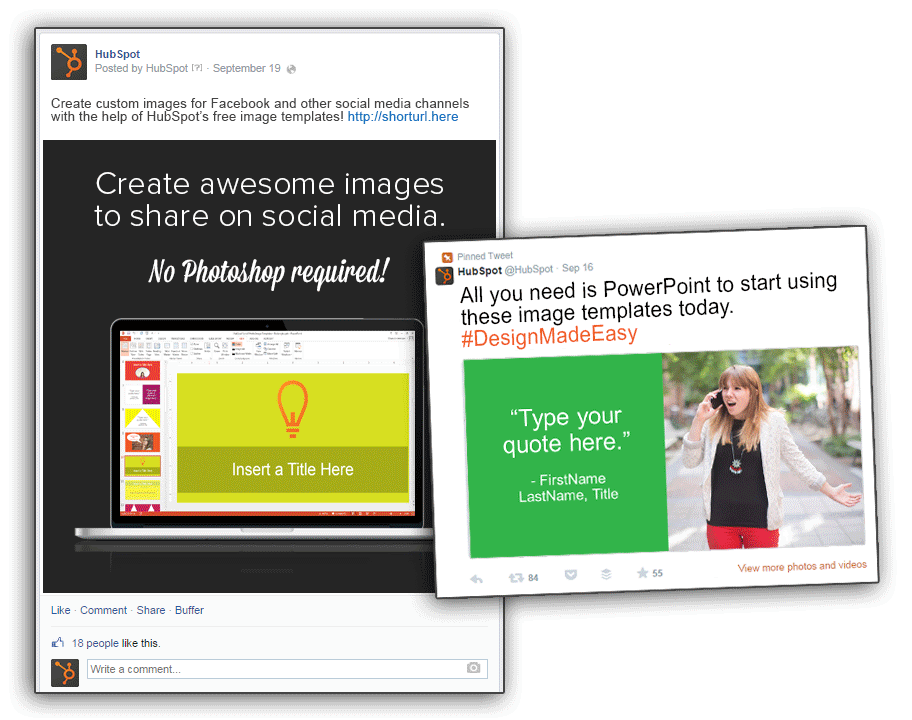
Hubspot practices what they preach, using diverse and eye-catching images in the brand’s own social media updates.

It makes particularly good use of the cover image sections of the various social sites in which they’re active. With each new campaign launch, a variety of accompanying visual imagery is rolled out, including cover images, customized by site.

Hubspot also takes advantage of the option to “pin” certain posts on Twitter and Facebook, allowing them to highlight a particular piece of content over a longer period of time.
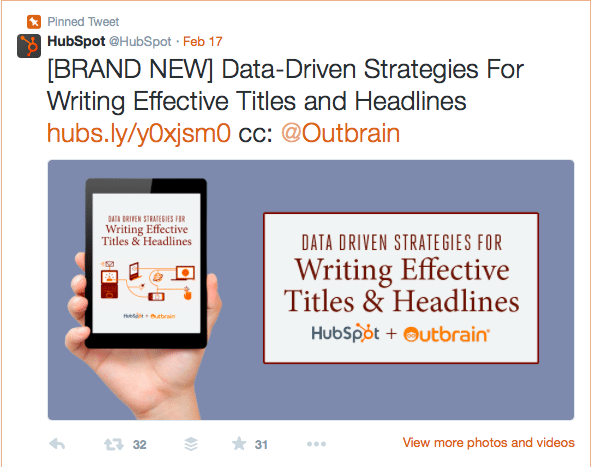
This is a strategy that Buffer has found can lead to up to 3 times the engagement on pinned posts:
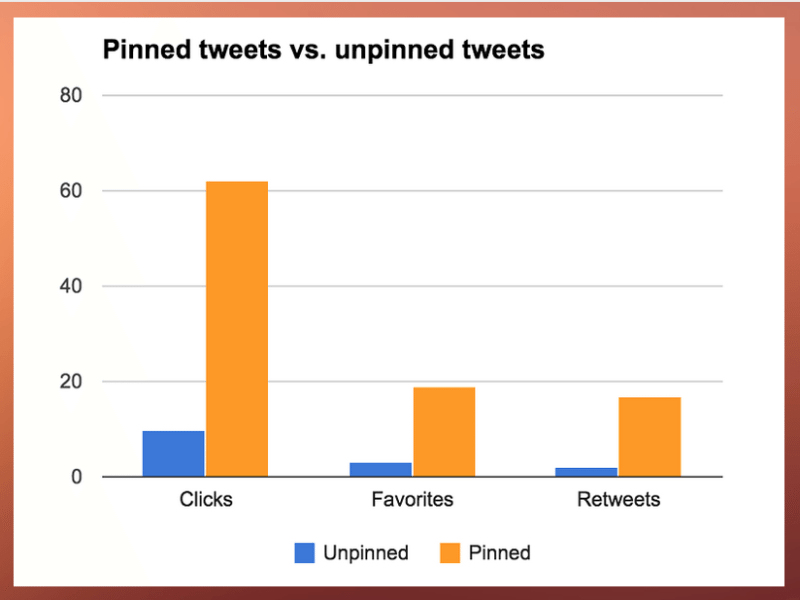
How you can go all in with images:
- Use Canva‘s easy-to-use templates for creating Facebook, G+, and Twitter cover images.
- Play around with tools like Piktochart and other infographic-creating tools to create eye-catching visuals like charts, headlines, and more, for all of your social media posts.
- Explore the photo resources in Buffer’s giant list of 53+ Free Image Sources For Your Blog and Social Media Posts.
- Download the unique (and free!) photos on Unsplash or Death to the Stock Photo to create sleek and beautiful images for your social accounts, blog posts, and more.
- Try Buffer’s new image creation tool Pablo to create custom, branded images in seconds
- Take visual posts that are performing well and pin them to the top of your social media timeline for even more mileage.
Lesson #2: Inspire like Red Bull
The thrill-seeking energy drink brand Red Bull gets huge per-post engagement from Instagram. Yet according to an analysis by SimplyMeasured, the company made fewer posts to Instagram than any of its other social networks, averaging just 0.6 posts per day.

Red Bull’s Instagram story is proof that it doesn’t matter how much content you publish. It matters what that content is.
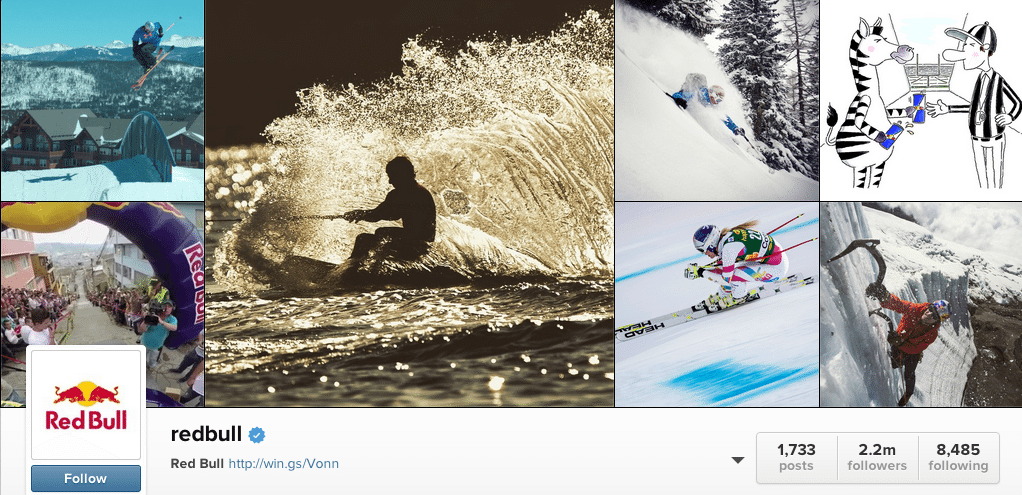
What makes Red Bull’s Instagram posts (and content in general) so engaging is its focus on two core values: action and inspiration.
Red Bull highlights people doing extraordinary things in extraordinary places. This content appeals to risk takers, recreational athletes, and all viewers who are stirred by the Red Bull vision of life.
The picture below, for example, has 66K likes. It drives engagement not because viewers can relate to it, but because it makes viewers stop in their tracks and say, “wow.”(Or, more likely to Red Bull’s audience, “sick.”)
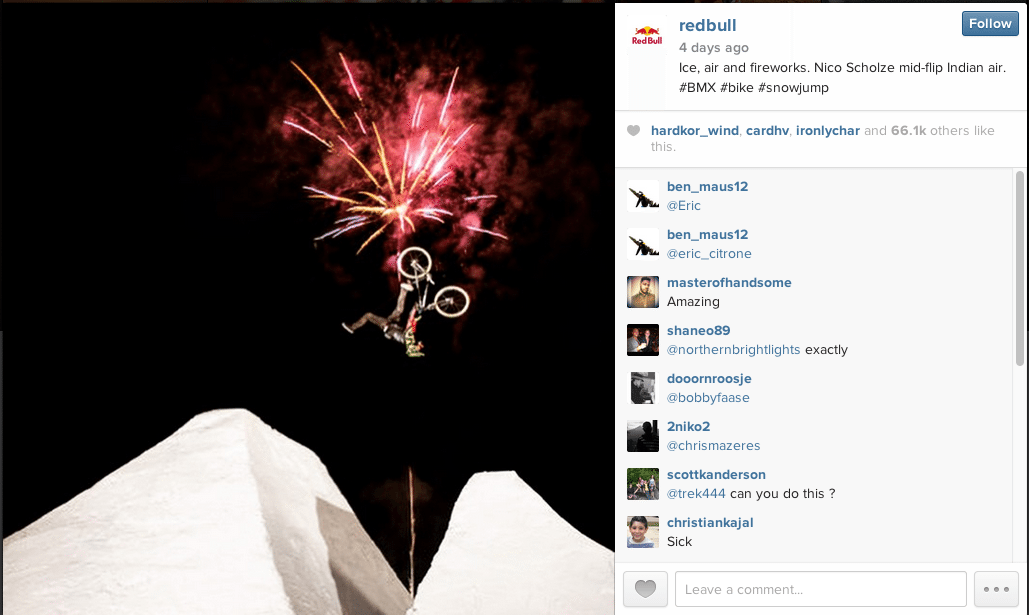
Red Bull also does a marvelous job unifying the subsections of its brand into a cohesive experience on Instagram.
Follow the main @redbull account and you see what you’d expect from the brand—epic, visual content of people doing “extreme” things. However, a closer look reveals a melding of the brand’s various areas of focus into one. Red Bull is active in sports, but also in music and art. Interspersed with people jumping off cliffs, are colorful and creative images that embody the same sentiment of living life in a big, inspiring way.

How you can inspire:
- Get to know your audience in-depth.
- Find out their likes and dislikes using Facebook’s business tools.
- Understand what they’re searching for using Google AdWords.
- Create marketing personas to help you understand what interests and excites each type of audience member that you can align with.
- Create content around not just your product but also the greater idea and values of your product. In an interview with Mashable, the freelance journalist Nicke Amies spoke about his experience writing for the Red Bull-financed magazine Red Bulletin:
“I’ve never been asked to crowbar Red Bull into any story I’ve done with them,” he said. “The promotion of the brand comes through the activities I cover.”
- Remember: People don’t buy products; they buy better versions of themselves.
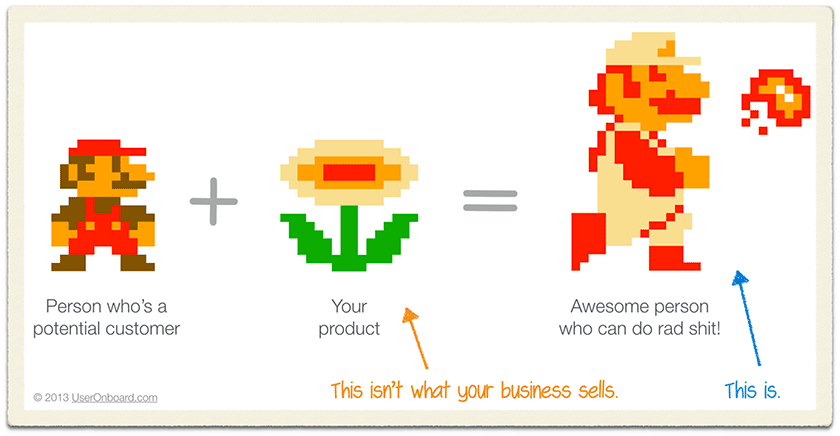 Sell the experience of your product, not just its features.
Sell the experience of your product, not just its features.
Lesson #3: Provide value like MailChimp
Pictures of people jumping out of the sky is definitely engaging. But that kind of content doesn’t make sense for many brands.
Even if you don’t think your industry is sexy, it is providing value. If it weren’t, you’d go out of business. Figure out the needs and wants of your audience, and deliver the content that meets those needs.
MailChimp does a great job of this. Their posts are data-heavy and value driven. They feature great go-to email guides, and spotlight trends that provide immediate value to their marketing audience.
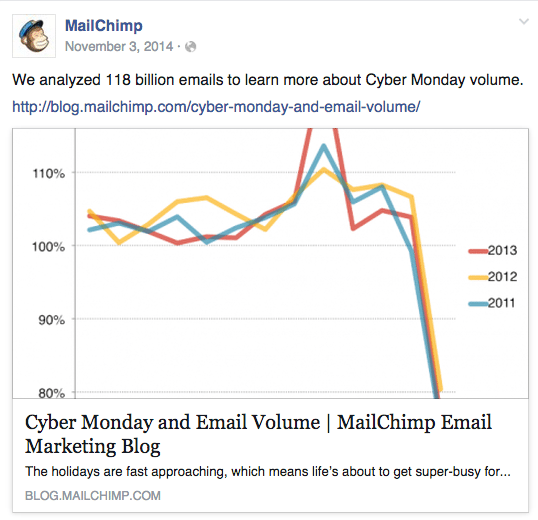
MailChimp is focused on not just providing customers with value through content, but also value through customer service. A quick look at the “Tweets & Replies” thread on their Twitter account reveals a regular cadence of warm replies, in a friendly rather than formal tone.

Notice how all the URLs in the above picture begin with “longreply.com?” The company is so dedicated to making customers feel valued that they actually built a product that allows customers to get in-depth answers quickly via social media, without having to send dozens of tweets back and forth.
How you can provide value:
- Fall in love with data. Dig into your own using Google Analytics, your social platforms, your CRM and marketing automation to identify trends that might hold value for your audience. Then, share them in a digestible format.
- Add research to your ideation and content creation process. (Here’s how Buffer researches!)
- Monitor data hubs like Pew Research and industry-specific resources like MarketingSherpa for insights you can share to benefit your users.
- Check out this awesome list of open data sources from visual.ly.
- Provide stellar social media customer service and add even more value by building your community.
Lesson #4: Show, don’t tell like Coca-Cola
The Coca-Cola company knows who they are, and what they stand for. The company’s mission, according to its website, is:
- To refresh the world – in mind, body and spirit
- To inspire moments of optimism – through our brands and actions
- To create value and make a difference everywhere we engage
But you don’t need to go to the company website to learn about these values. Coca-Cola showcases them throughout their social channels, featuring warmhearted stories of generosity and goodwill that beg to be shared.
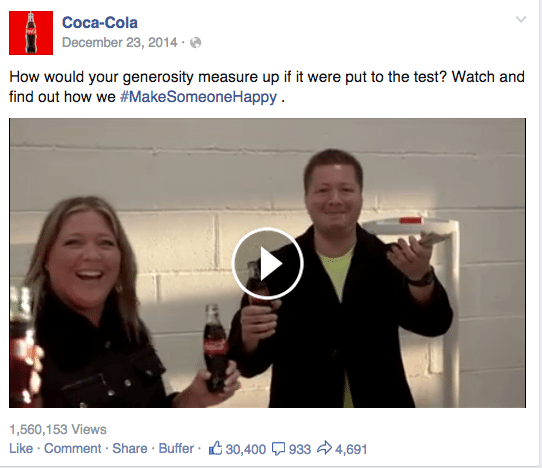
Coca-Cola shares around the globe these stories that naturally highlight and unify its mission and values. Its YouTube channel isn’t divided up into smaller sub-channels by country, region or product line, for example. Instead, it features video stories from all over the world in one place.
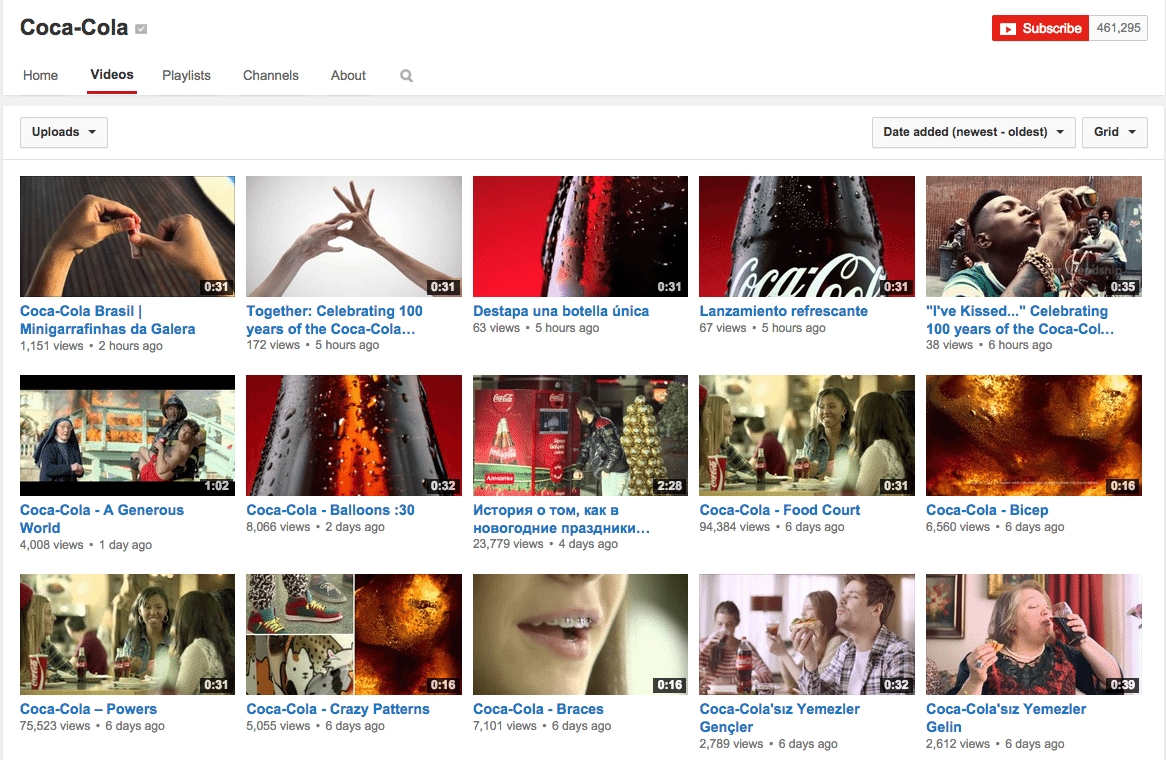
How you can show:
- Have a clear vision of your brand’s values. If you don’t have a clear understanding of your brand’s values, you won’t inspire your audience. Document your brand values, circulate them, and showcase them throughout your messaging.
- Walk the walk. If your brand cares about the environment, show it with stories about specific projects, initiatives and outcomes. Maybe that’s with content about the recycled material you use for your products, or the fact that your factory uses solar energy.
Lesson #5: Feature your customers like Square
Social media is for making human connections. If your brand starts to feel too transactional, users could tune you out. A great way to keep the human element alive and strong within your corporate social accounts is to feature the human side of your customers.
Square does a great job of this. Its “Square Stories” collection doesn’t just feature the company’s mobile payments product, but — more importantly — how the product influences the real lives and relationships of the people who use it.
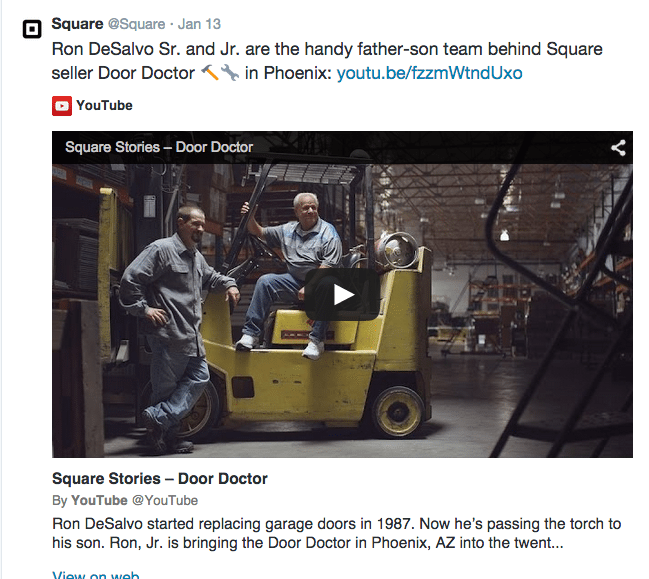
The kind of content that says “others just like you have done this” is great for social media. It makes your audience feel more intimately connected to the product or service they’re buying, and deepens their relationship with the company interested in their success.
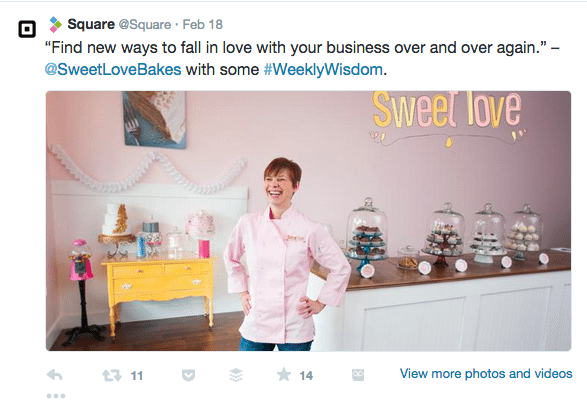
How you can feature your customers:
- Work with your customer success or service team to understand who your customers are and how they’re using your product. This ultimate case study guide from HubSpot is a great place to start.
- Go beyond the typical case study: visit customers in their own environment and document the meeting. Showcase their surroundings, their challenges, and their triumphs.
- Celebrate diversity. Your users likely don’t use their product in exactly the same way. Celebrate the differences in your customer stories. Your readers will be more likely to see themselves in your customers.
Lesson #6: Display your culture like Intuit
Intuit is one of the rare B2B brands using Pinterest with great success.
Its most popular profile is the Intuit Careers profile: 36 distinct boards highlight the company’s status as one of Fortune’s “100 Best Companies to Work For.” The boards showcase the people that make up the company while offering lifestyle tips and advice for potential job seekers.
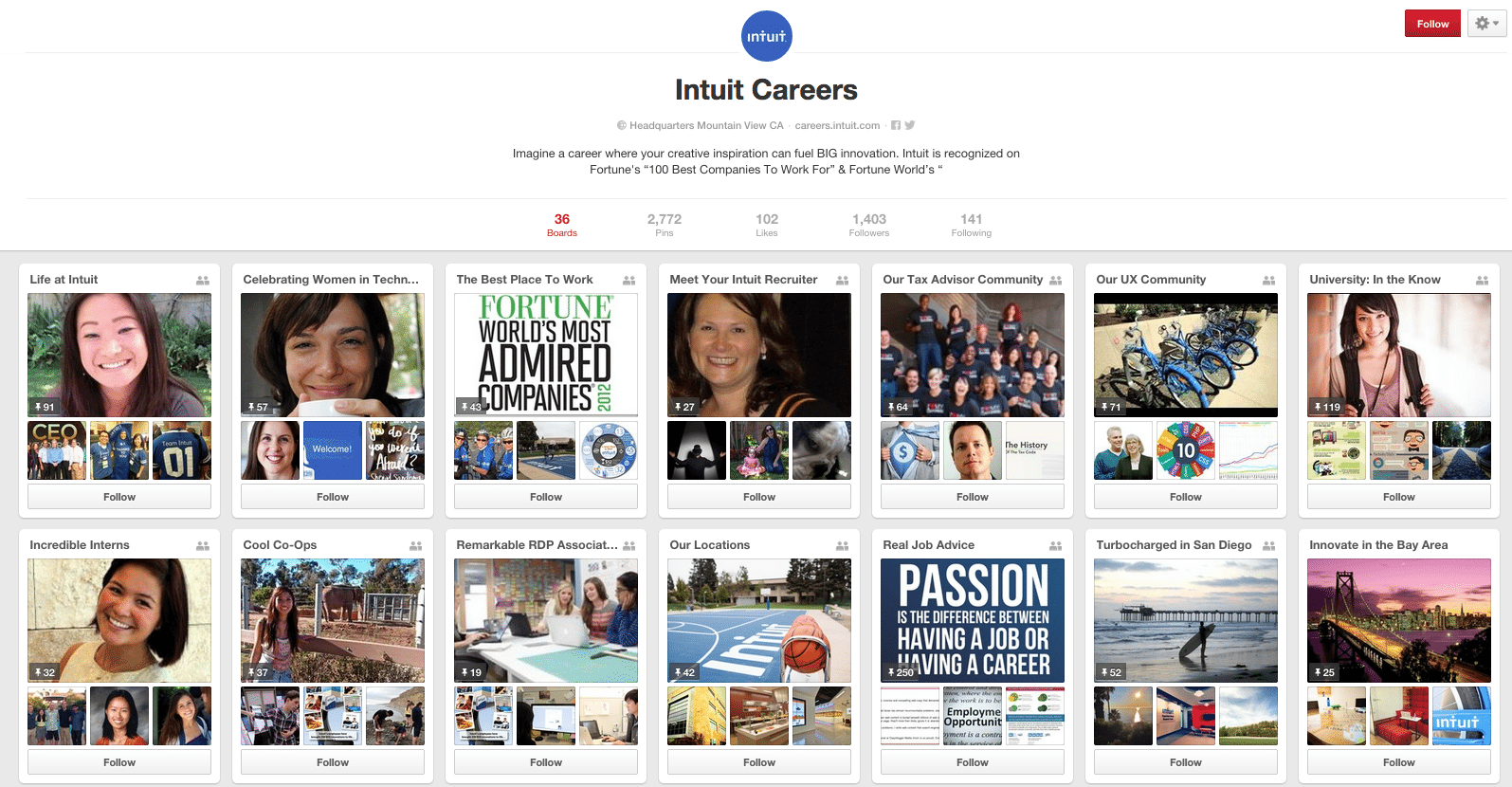
Regardless of your company’s size, recruiting great talent is likely a major focus. You need people who can not only succeed in the position they’re hired for, but also blend well with your company culture. Intuit presents a great way to use social media to highlight what it is that makes a great employee there.
How you can display your culture:
- Work with your HR department to spotlight the individuals who make up your organization. Interview your colleagues about their passions, their preferences, their quirky habits. Weird is usually better.
- Document company outings, happy hours, and meetings. The more human you come across, the more your audience will love you.
What are your biggest lessons?
You can implement any of these social media strategies starting today, based on your company values and the needs of your target audience. Pick and choose from the brands above to find the right mix for your company.
And, don’t forget to experiment early and often. One of the best things about social media is that you get immediate feedback. You’ll soon understand what’s really resonating with your followers and what isn’t.
What are your biggest social media marketing lessons? What are some brands you’ve noticed doing an amazing job? Share your thoughts in the comments and keep the conversation going!
Try Buffer for free
190,000+ creators, small businesses, and marketers use Buffer to grow their audiences every month.


